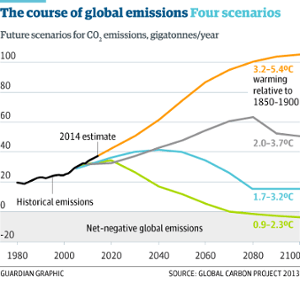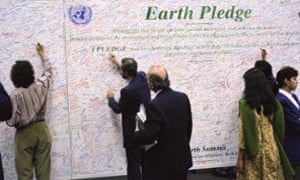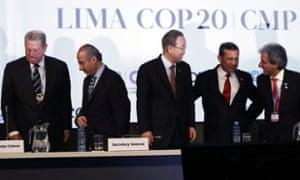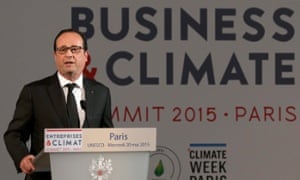As UN climate negotiations resume in Bonn, we look at why the crunch Paris climate conference from 30 November to 11 December is so important
What is happening in Paris this December?
The governments of more than 190 nations will gather in Paris to discuss a possible new global agreement on climate change, aimed at reducing global greenhouse gas emissions and thus avoiding the threat of dangerous climate change.
Why now?
Current commitments on greenhouse gas emissions run out in 2020, so at Paris governments are expected to produce an agreement on what happens for the decade after that at least, and potentially beyond.
Why is this important?
Scientists have warned that if greenhouse gas emissions continue to rise, we will pass the threshold beyond which global warming becomes catastrophic and irreversible. That threshold is estimated as a temperature rise of 2C above pre-industrial levels, and on current emissions trajectories we are heading for a rise of about 5C. That may not sound like much, but the temperature difference between today’s world and the last ice age was about 5C, so seemingly small changes in temperature can mean big differences for the Earth.

Why has nobody thought of getting a global agreement on this before now?
They have: global negotiations on climate change have been carrying on for more than 20 years. The history of climate change goes back much further: in the 19th century, physicists theorised about the role of greenhouse gases, chiefly carbon dioxide, in the atmosphere, and several suggested that the warming effect would increase alongside the levels of these gases in the atmosphere. But this was all theoretical.
Only in the past few decades have scientists begun the measurements necessary to establish a relationship between current carbon levels and temperatures, and the science conducted since then has consistently pointed in one direction: that rising greenhouse gas emissions, arising from our use of fossil fuels and our industries, lead to higher temperatures.
Hasn’t global warming stopped?
No. Global temperatures have been on a clear upward path. There was a spike in 1998, after which temperatures were lower – but still warmer than previous decades – that led some climate sceptics to claim that the world was cooling.
During the period since 1998, global temperatures have risen at a slower pace than they did in the previous 30 years. That, too, has been seized upon by sceptics as evidence that global warming has “paused”.
But it is important to note that temperatures have not fallen, or stalled – they have continued to rise. Given the variations that characterise our weather systems, a period in which the rate of warming slowed is not unexpected.
For the past two years, the rate of warming seems to have accelerated again, but little can be construed from that.
People sign the Earth pledge made at the the UN Conference on Environment and Development (UNCED) in June 1992. Photograph: UN Photo
What progress have we seen on a global agreement?
In 1992, governments met in Rio de Janeiro and forged the United Nations Framework Convention on Climate Change. That agreement, still in force, bound governments to take action to avoid dangerous climate change, but did not specify what actions. Over the following five years, governments wrangled over what each should do, and what should be the role of developed countries versus poorer nations.
Those years of argument produced, in 1997, the Kyoto protocol. That pact required worldwide cuts in emissions of about 5%, compared with 1990 levels, by 2012, and each developed country was allotted a target on emissions reductions. But developing countries, including China, South Korea, Mexico and other rapidly emerging economies, were given no targets and allowed to increase their emissions at will.
Al Gore, then US vice president, signed up to the protocol, but it was quickly apparent that it would never be ratified by the US Congress. Legally, the protocol could not come into force until countries representing 55% of global emissions had ratified it. With the US – then the world’s biggest emitter – on the outside, that was not going to happen.
So for most of the following decade, the Kyoto protocol remained in abeyance and global climate change negotiations ground to a near-halt. But in late 2004, Russia decided to pass the treaty – unexpectedly, and as part of a move to have its application for World Trade Organisation membership accepted by the European Union. That made up the weight needed, and the protocol finally came into force.
So we had a global agreement?
Not quite. The US, under George W Bush, remained firmly outside Kyoto, so although the UN negotiations carried on year after year, the US negotiators were often in different rooms from the rest of the world. It was clear a new approach was needed that could bring the US in, and encourage the major developing economies – especially China, now the world’s biggest emitter – to take on limits to their emissions.
What followed was, agreed at Bali in 2007 after much drama, an action plan that set the world on the course to a new agreement that would take over from Kyoto.
This is taking a long time. What happened next?
It did take a long time. But getting agreement from 196 countries was never going to be easy. The next act of this long-running drama fully demonstrated that: theCopenhagen conference of 2009.
US President Barack Obama along with European leaders including German Chancellor Angela Merkel, centre, attend negotiations on the final night of the Copenhagen UN Climate Change summit in Denmark on 18 December 2009. Photograph: Pool/Getty Images
What happened at Copenhagen?
Everything but the treaty. All of the world’s developed countries and the biggest developing countries agreed – for the first time – to limits on their greenhouse gas emissions. This was a landmark, as it meant the world’s biggest emitters were united towards a single goal.
The emissions reductions agreed on were still not enough to meet scientific advice, but they were a big advance on reducing emissions compared with “business as usual”.
But what didn’t happen turned out to be the point that NGOs and many in the press seized on. What didn’t happen was a fully articulated and legally binding treaty.
Is that important?
It depends on your viewpoint. The Kyoto protocol was a beautifully written, watertight, fully legally binding international treaty, a sub-treaty of the similarly binding UNFCCC. But it never met its objectives, because it wasn’t ratified by the US, and not by Russia until it was too late. And none of the countries that failed to meet their commitments under Kyoto have been sanctioned.
The Copenhagen agreement, on the other hand, was not fully adopted by the UN in 2009 because of last-minute chaos at the conference, though it was ratified the following year in the form of the Cancun agreements. For this reason, the Copenhagen agreement was derided as a failure by green groups
But the targets agreed at Copenhagen, in the form of a document signed by world leaders, still stand.
What is likely to be agreed in Paris?

We know already what the biggest emitters have committed to. The EU will cut its emissions by 40%, compared with 1990 levels, by 2030. The US will cut its emissions by 26% to 28%, compared with 2005 levels, by 2025. China will agree that its emissions will peak by 2030.
Other major countries, including India, have yet to come up with their targets – known in the UN jargon as INDCs – despite being asked to meet a deadline at the end of March.
If the commitments from the major countries are in the bag, does that mean the Paris agreement is settled?
Not at all – the other key question, apart from emissions reduction, is finance. Poorer countries want the rich world to provide them with financial help that will enable them to invest in clean technology to cut their greenhouse gas emissions, and to adapt their infrastructure to the likely damage from climate change.
This is a hugely contentious issue. At Copenhagen, where the finance part of the deal was only sorted out at the very last minute, rich countries agreed to supply $30bn ($20bn) of “fast-start” financial assistance to the poor nations, and they said that by 2020, financial flows of at least $100bn a year would be provided.
Poor nations want a similar provision in place beyond 2020, but there is strong disagreement over how this should be done. Some want all the money to come from rich country governments, but those governments are adamant that they will not provide such funding solely from the public purse. They want international development banks, such as the World Bank, to play a role, and they want most of the funding to come from the private sector.
An agreement on this is still possible, but it will be one of the main obstacles to a Paris deal.
Will world leaders go to Paris to agree this?
No. World leaders, including Barack Obama and the Chinese premier Wen Jiabao, attended Copenhagen but were then embarrassed when that conference ended in scenes of chaos and vicious recriminations. So they’re not coming back. Paris will be attended by high-level ministers of all the world’s governments, who have the power to sign a deal on behalf of their countries.
On behalf of the French government, the conference will be led by foreign minister Laurent Fabius, and environment minister Segolene Royal, but the French president Francois Hollande will also play a key role. They are all confident that a deal can be made.
What else can we expect before Paris?
Plenty. There will be a long series of meetings in the run-up to the conference, which have already begun: in late May, a business and climate summit brought together leading private sector companies and government officials; in June, a meeting in Bonn to hammer out some of the key details of the negotiating text; in July, a meeting of scientists; in September, a convening of world leaders as part of the UN annual general meeting; and more meetings of officials, negotiators, ministers and civil society throughout the autumn.
It is also important to note that the climate talks are not happening in a vacuum.
The UN is also pressing world governments to produce a set of “sustainable development goals” this autumn, which will take over from the millennium development goals that were pegged to 2015. These will include issues such as access to clean water and sanitation, access to energy, gender equality, education and health. Those SDGs will have a profound effect on whether the world can meet its climate change targets, and meet them in an equitable fashion that allows poor countries to lift their citizens out of poverty while not passing climate thresholds.
This will be a key year for international relations. If nations can meet and agree equitable goals on the climate, on economic development, on social and environmental issues, and do so in a spirit of cooperation, it will bode well for future development.
But, as the French president Francois Hollande told delegates in Paris in late May, that might be hoping for a “miracle”.






























